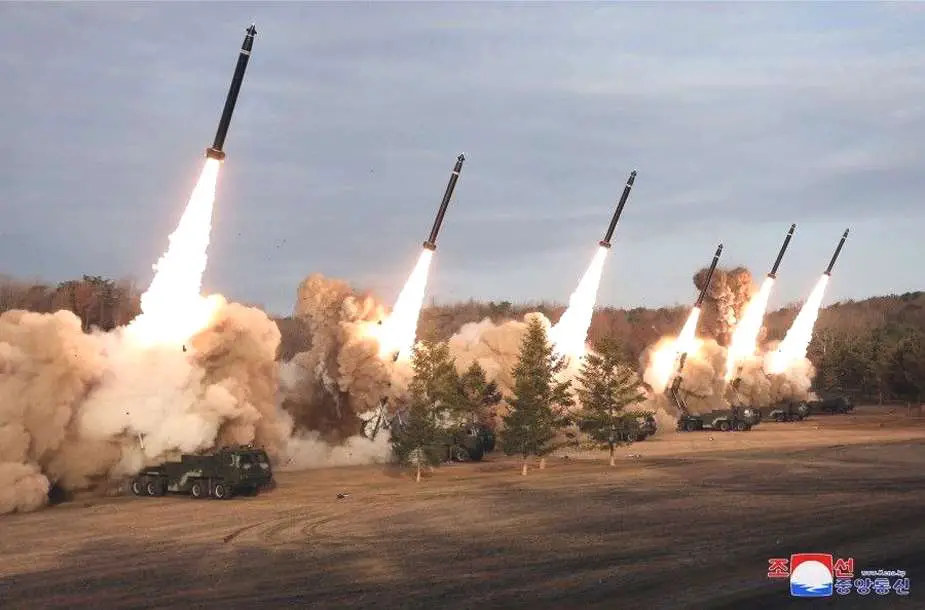Breaking news
North Korea Conducts Live Firing Exercise with New KN-25 600mm MLRS Rocket Launchers.
Recently, images were released by the North Korean News Agency (KCNA) showcasing a live firing drill conducted by the North Korean military, featuring its latest advancement in Multiple Launch Rocket Systems, dubbed the KN-25. Frequently described as a "super-large 600-mm Multiple Launch Rocket System (MLRS)," the KN-25 redefines the traditional boundaries between rocket artillery and operational-tactical missile systems with its impressive range of up to 380 km. Given its capabilities, the KN-25 has been categorized by the United States Forces Korea (USFK) as a short-range ballistic missile (SRBM).
Follow Army Recognition on Google News at this link

North Korea conducted live firing exercises with its new KN-25 600mm MLRS Multiple Launch Rocket System. (Picture source KCNA)
The development and deployment of the KN-25 Multiple Launch Rocket System (MLRS) reflect North Korea's strategic intent to project power and ensure deterrence, with recent tests showcasing the system's advanced technical capabilities and operational flexibility.
The recent battery salvos conducted with the KN-25 MLRS have marked a significant milestone in North Korea's military exercises. Unlike previous tests, which were limited to launches from individual units, these latest exercises utilized an automated battery command and control system. This development not only demonstrates an advancement in North Korea's military technology but also signifies an increased focus on operational readiness and precision in missile launches. The tests targeted small islands, demanding high accuracy to successfully hit such constrained areas and thus proving the missile's precision and reliability.
The KN-25 missile, with its 600 mm diameter, 8.2 meters length, and 3,000 kg weight, embodies a significant leap in North Korea's missile technology. Its design incorporates an unspecified guidance system and features six rotating rear fins alongside four moving forward fins. This configuration, particularly the rotating rear fins, marks a considerable innovation, diverging from traditional spin-stabilized rocket artillery by stabilizing the rocket in flight without rotating the entire body. Such a system enhances the missile's guidance system's effectiveness by maintaining a stable platform.
Mounted on versatile platforms, including a four-tube Tatra 813 8×8 wheeled transporter-erector-launcher (TEL) or a tracked armored chassis carrying six tube launchers, the KN-25 boasts rapid mobility and deployment capabilities. This flexibility ensures the missile system can be swiftly redeployed, enhancing its survivability and tactical utility on the battlefield. With a range of up to 380 km and equipped with a conventional blast-fragmentation warhead, the KN-25 is adept at targeting enemy rear-echelon areas, making it a potent tool for battalion-level engagements.
Further underlining its strategic value, North Korea has included the KN-25 in its arsenal of weapons capable of delivering tactical nuclear warheads. Demonstrations at military parades and official statements have referred to the KN-25 and similar systems as "tactical nuclear weapons operation units," signaling a significant shift in the North's military posture and deterrence strategy.
The technical evolution of the KN-25 suggests it may have been inspired by the OTR-21 Tochka/KN-02 Toksa, with adaptations that have significantly enhanced its performance. The missile's heavy warhead and accuracy—with a circular error probable (CEP) of 80 to 90 meters—indicate a focus on precision and lethality. Described in state media as a product of indigenous research and celebrated as "Juche projectiles," the KN-25 represents a cornerstone of North Korea's self-reliant defense strategy.
The strategic deployment of the KN-25 system showcased through the presentation of 30 TELs at a significant political gathering, underscores its importance to North Korea's military and political leadership. This gesture highlighted the system's unprecedented capabilities and the country's ability to saturate adversary defenses with a high volume of projectiles, demonstrating a sophisticated understanding of modern warfare's demands.
Defense News March 2024























